Ruei-Sung Lin
ZALM3: Zero-Shot Enhancement of Vision-Language Alignment via In-Context Information in Multi-Turn Multimodal Medical Dialogue
Sep 26, 2024
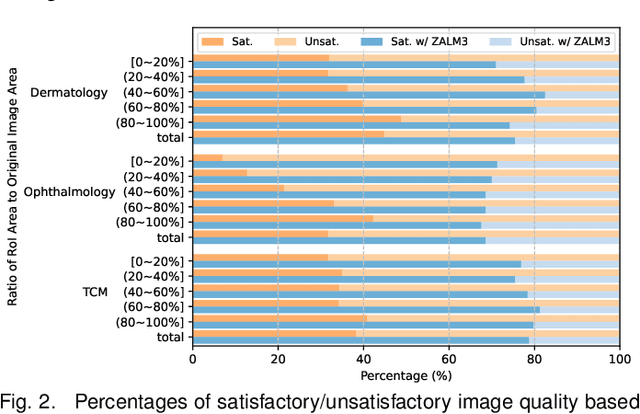
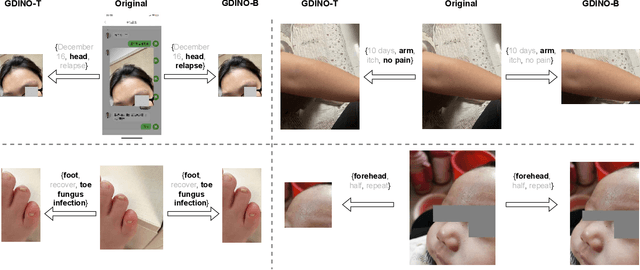
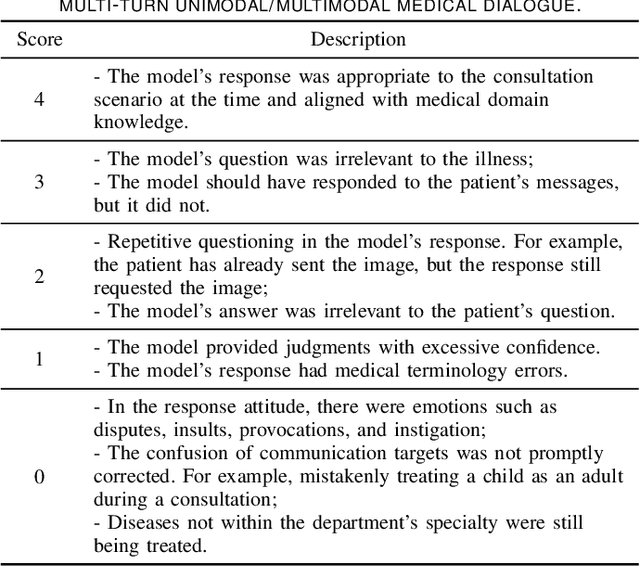
Abstract:The rocketing prosperity of large language models (LLMs) in recent years has boosted the prevalence of vision-language models (VLMs) in the medical sector. In our online medical consultation scenario, a doctor responds to the texts and images provided by a patient in multiple rounds to diagnose her/his health condition, forming a multi-turn multimodal medical dialogue format. Unlike high-quality images captured by professional equipment in traditional medical visual question answering (Med-VQA), the images in our case are taken by patients' mobile phones. These images have poor quality control, with issues such as excessive background elements and the lesion area being significantly off-center, leading to degradation of vision-language alignment in the model training phase. In this paper, we propose ZALM3, a Zero-shot strategy to improve vision-language ALignment in Multi-turn Multimodal Medical dialogue. Since we observe that the preceding text conversations before an image can infer the regions of interest (RoIs) in the image, ZALM3 employs an LLM to summarize the keywords from the preceding context and a visual grounding model to extract the RoIs. The updated images eliminate unnecessary background noise and provide more effective vision-language alignment. To better evaluate our proposed method, we design a new subjective assessment metric for multi-turn unimodal/multimodal medical dialogue to provide a fine-grained performance comparison. Our experiments across three different clinical departments remarkably demonstrate the efficacy of ZALM3 with statistical significance.
DiffMOT: A Real-time Diffusion-based Multiple Object Tracker with Non-linear Prediction
Mar 04, 2024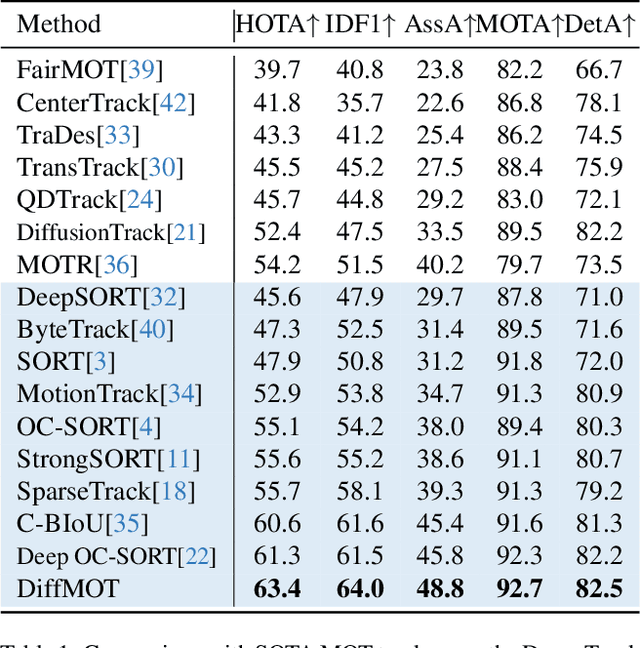
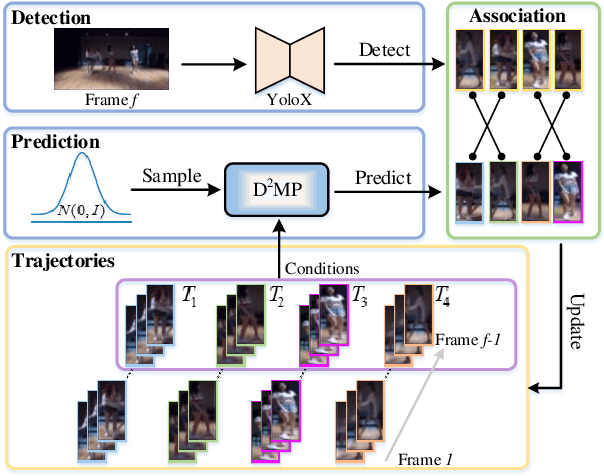
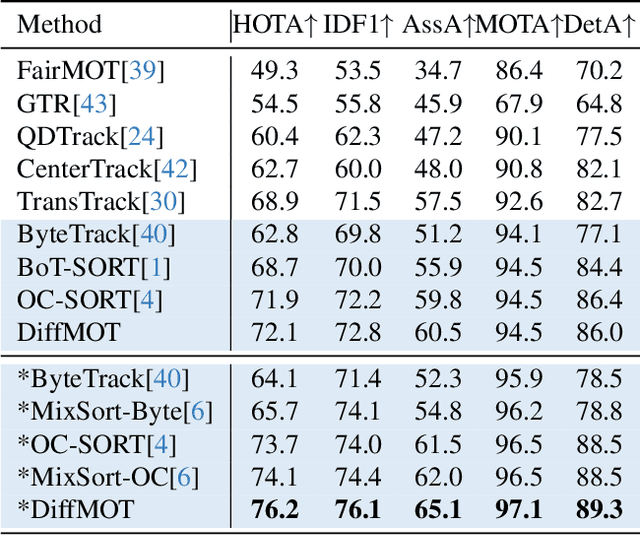
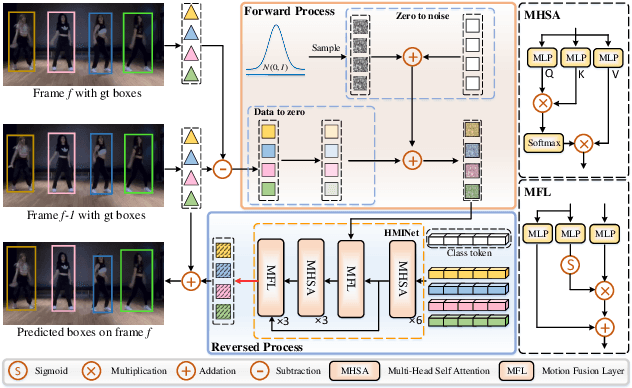
Abstract:In Multiple Object Tracking, objects often exhibit non-linear motion of acceleration and deceleration, with irregular direction changes. Tacking-by-detection (TBD) with Kalman Filter motion prediction works well in pedestrian-dominant scenarios but falls short in complex situations when multiple objects perform non-linear and diverse motion simultaneously. To tackle the complex non-linear motion, we propose a real-time diffusion-based MOT approach named DiffMOT. Specifically, for the motion predictor component, we propose a novel Decoupled Diffusion-based Motion Predictor (D MP). It models the entire distribution of various motion presented by the data as a whole. It also predicts an individual object's motion conditioning on an individual's historical motion information. Furthermore, it optimizes the diffusion process with much less sampling steps. As a MOT tracker, the DiffMOT is real-time at 22.7FPS, and also outperforms the state-of-the-art on DanceTrack and SportsMOT datasets with 63.4 and 76.2 in HOTA metrics, respectively. To the best of our knowledge, DiffMOT is the first to introduce a diffusion probabilistic model into the MOT to tackle non-linear motion prediction.
Bidirectional Autoregressive Diffusion Model for Dance Generation
Feb 06, 2024Abstract:Dance serves as a powerful medium for expressing human emotions, but the lifelike generation of dance is still a considerable challenge. Recently, diffusion models have showcased remarkable generative abilities across various domains. They hold promise for human motion generation due to their adaptable many-to-many nature. Nonetheless, current diffusion-based motion generation models often create entire motion sequences directly and unidirectionally, lacking focus on the motion with local and bidirectional enhancement. When choreographing high-quality dance movements, people need to take into account not only the musical context but also the nearby music-aligned dance motions. To authentically capture human behavior, we propose a Bidirectional Autoregressive Diffusion Model (BADM) for music-to-dance generation, where a bidirectional encoder is built to enforce that the generated dance is harmonious in both the forward and backward directions. To make the generated dance motion smoother, a local information decoder is built for local motion enhancement. The proposed framework is able to generate new motions based on the input conditions and nearby motions, which foresees individual motion slices iteratively and consolidates all predictions. To further refine the synchronicity between the generated dance and the beat, the beat information is incorporated as an input to generate better music-aligned dance movements. Experimental results demonstrate that the proposed model achieves state-of-the-art performance compared to existing unidirectional approaches on the prominent benchmark for music-to-dance generation.
HSTFormer: Hierarchical Spatial-Temporal Transformers for 3D Human Pose Estimation
Jan 18, 2023Abstract:Transformer-based approaches have been successfully proposed for 3D human pose estimation (HPE) from 2D pose sequence and achieved state-of-the-art (SOTA) performance. However, current SOTAs have difficulties in modeling spatial-temporal correlations of joints at different levels simultaneously. This is due to the poses' spatial-temporal complexity. Poses move at various speeds temporarily with various joints and body-parts movement spatially. Hence, a cookie-cutter transformer is non-adaptable and can hardly meet the "in-the-wild" requirement. To mitigate this issue, we propose Hierarchical Spatial-Temporal transFormers (HSTFormer) to capture multi-level joints' spatial-temporal correlations from local to global gradually for accurate 3D HPE. HSTFormer consists of four transformer encoders (TEs) and a fusion module. To the best of our knowledge, HSTFormer is the first to study hierarchical TEs with multi-level fusion. Extensive experiments on three datasets (i.e., Human3.6M, MPI-INF-3DHP, and HumanEva) demonstrate that HSTFormer achieves competitive and consistent performance on benchmarks with various scales and difficulties. Specifically, it surpasses recent SOTAs on the challenging MPI-INF-3DHP dataset and small-scale HumanEva dataset, with a highly generalized systematic approach. The code is available at: https://github.com/qianxiaoye825/HSTFormer.
Prior-enhanced Temporal Action Localization using Subject-aware Spatial Attention
Nov 10, 2022Abstract:Temporal action localization (TAL) aims to detect the boundary and identify the class of each action instance in a long untrimmed video. Current approaches treat video frames homogeneously, and tend to give background and key objects excessive attention. This limits their sensitivity to localize action boundaries. To this end, we propose a prior-enhanced temporal action localization method (PETAL), which only takes in RGB input and incorporates action subjects as priors. This proposal leverages action subjects' information with a plug-and-play subject-aware spatial attention module (SA-SAM) to generate an aggregated and subject-prioritized representation. Experimental results on THUMOS-14 and ActivityNet-1.3 datasets demonstrate that the proposed PETAL achieves competitive performance using only RGB features, e.g., boosting mAP by 2.41% or 0.25% over the state-of-the-art approach that uses RGB features or with additional optical flow features on the THUMOS-14 dataset.
Accurate and Robust Lesion RECIST Diameter Prediction and Segmentation with Transformers
Aug 28, 2022



Abstract:Automatically measuring lesion/tumor size with RECIST (Response Evaluation Criteria In Solid Tumors) diameters and segmentation is important for computer-aided diagnosis. Although it has been studied in recent years, there is still space to improve its accuracy and robustness, such as (1) enhancing features by incorporating rich contextual information while keeping a high spatial resolution and (2) involving new tasks and losses for joint optimization. To reach this goal, this paper proposes a transformer-based network (MeaFormer, Measurement transFormer) for lesion RECIST diameter prediction and segmentation (LRDPS). It is formulated as three correlative and complementary tasks: lesion segmentation, heatmap prediction, and keypoint regression. To the best of our knowledge, it is the first time to use keypoint regression for RECIST diameter prediction. MeaFormer can enhance high-resolution features by employing transformers to capture their long-range dependencies. Two consistency losses are introduced to explicitly build relationships among these tasks for better optimization. Experiments show that MeaFormer achieves the state-of-the-art performance of LRDPS on the large-scale DeepLesion dataset and produces promising results of two downstream clinic-relevant tasks, i.e., 3D lesion segmentation and RECIST assessment in longitudinal studies.
PieTrack: An MOT solution based on synthetic data training and self-supervised domain adaptation
Jul 22, 2022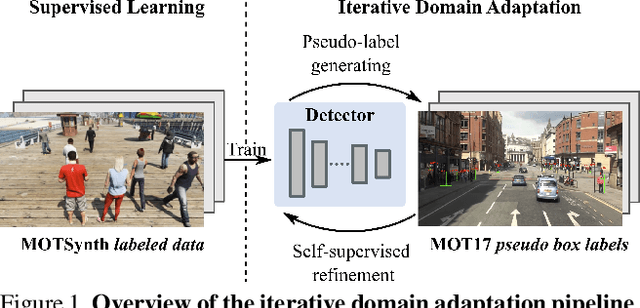
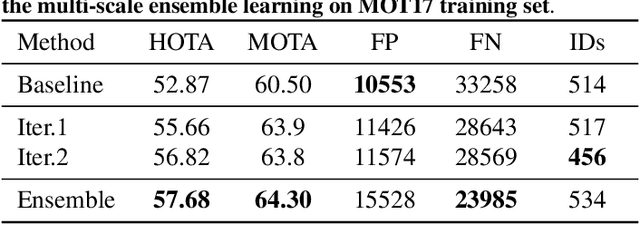
Abstract:In order to cope with the increasing demand for labeling data and privacy issues with human detection, synthetic data has been used as a substitute and showing promising results in human detection and tracking tasks. We participate in the 7th Workshop on Benchmarking Multi-Target Tracking (BMTT), themed on "How Far Can Synthetic Data Take us"? Our solution, PieTrack, is developed based on synthetic data without using any pre-trained weights. We propose a self-supervised domain adaptation method that enables mitigating the domain shift issue between the synthetic (e.g., MOTSynth) and real data (e.g., MOT17) without involving extra human labels. By leveraging the proposed multi-scale ensemble inference, we achieved a final HOTA score of 58.7 on the MOT17 testing set, ranked third place in the challenge.
Optimal Transport Based Generative Autoencoders
Oct 16, 2019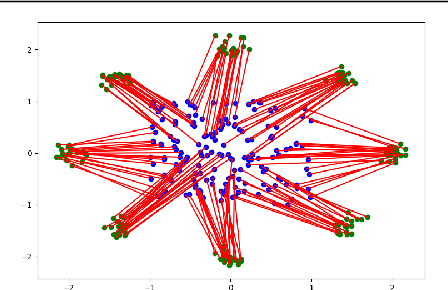
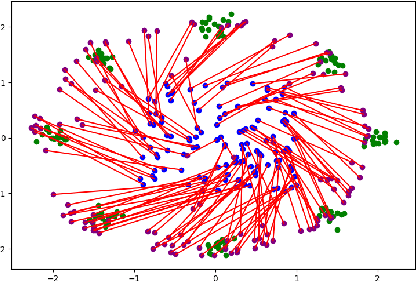
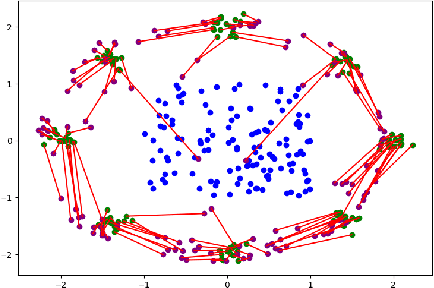
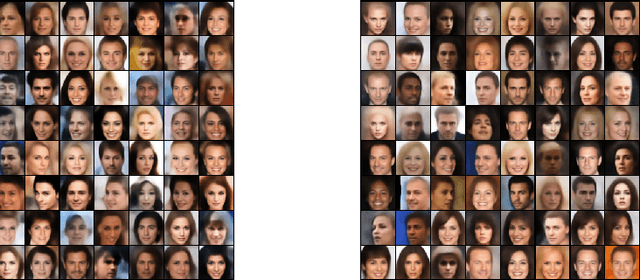
Abstract:The field of deep generative modeling is dominated by generative adversarial networks (GANs). However, the training of GANs often lacks stability, fails to converge, and suffers from model collapse. It takes an assortment of tricks to solve these problems, which may be difficult to understand for those seeking to apply generative modeling. Instead, we propose two novel generative autoencoders, AE-OTtrans and AE-OTgen, which rely on optimal transport instead of adversarial training. AE-OTtrans and AEOTgen, unlike VAE and WAE, preserve the manifold of the data; they do not force the latent distribution to match a normal distribution, resulting in greater quality images. AEOTtrans and AE-OTgen also produce images of higher diversity compared to their predecessor, AE-OT. We show that AE-OTtrans and AE-OTgen surpass GANs in the MNIST and FashionMNIST datasets. Furthermore, We show that AE-OTtrans and AE-OTgen do state of the art on the MNIST, FashionMNIST, and CelebA image sets comapred to other non-adversarial generative models.
 Add to Chrome
Add to Chrome Add to Firefox
Add to Firefox Add to Edge
Add to Edge